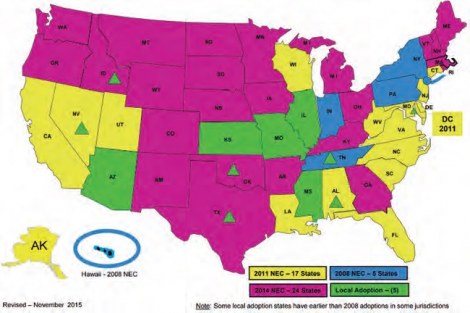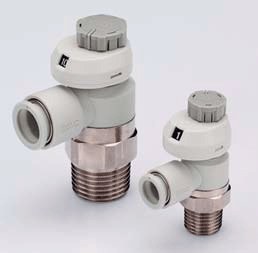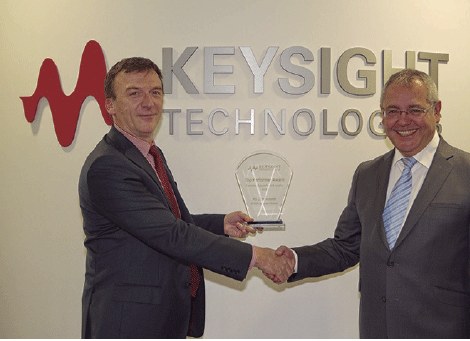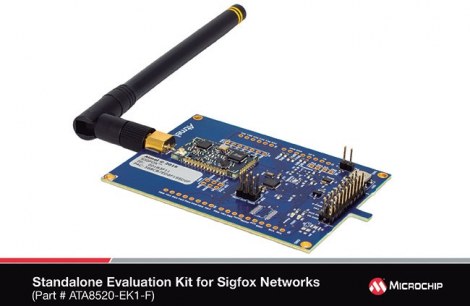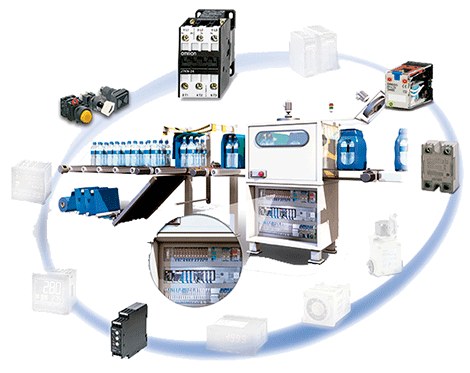One of the first considerations that a European manufacturer must make when thinking of introducing their electrical or electronic product in the North American market, is to find out what the applicable regulations are to ensure the conformity of their product. In most cases, the regulations in North America and Europe are totally different, and the CE Marking has no validity. Legislation in North America requires that products placed on the market comply with applicable regulations, but contrary to popular belief, with very few exceptions, it does not require products to be certified by an accredited body.
Product Compliance in North America
The codes Product compliance in the United States begins with codes. There are specific codes for electrical installations, building, fire control, plumbing, gas, and others. Codes are developed and published by independent bodies (ICC, NFPA, etc.). The fact that a code is published does not imply that its application is mandatory: only when a code is adopted by a State does it become binding, that is, it becomes law. By adopting it, States may even adapt such a code according to their own preferences or needs. Local authorities within a State, at the city or county level, may also decide to supplement the codes adopted by the State with local standards and regulations. Regarding electrical safety , the most widely used code by the States is the NFPA70 or National Electrical Code (NEC), which is developed by the National Fire Protection Association (NFPA) and updated every 3 years. The NEC specifies installation requirements to prevent personal safety risks. It is important to note that not all states adopt the NEC, and among those that do, not all have the same version in effect. The map in Figure 1 shows the current state. of the adoption of the NEC by the different North American states.
The
In addition to codes, there are non-governmental organizations that develop and publish standards. The standards (as well as the codes) are usually developed by consensus in work groups in which different actors are represented (manufacturers, certifiers, laboratories, the government, insurers, etc.). The standards contain requirements that products and facilities must meet to ensure safety and performance during their end use. Codes and standards are fully linked and complement each other. For example, a building code may require notification of presence through audible alerts; Here the NFPA 72 standard would come into play, which requires that said sound alert give a level of 15 dBA above ambient sound. To achieve this level, the designer must install the appropriate number of loudspeakers in the enclosure, spacing them appropriately to meet this requirement, while full system verification could be done against the UL464 product standard.
Verification of compliance with applicable regulations
Verification of compliance with applicable codes, rules and regulations is the responsibility of the so-called “Authorities Having Jurisdiction” (“AHJ”). The NFPA defines AHJ as “An organization, office, or individual responsible for enforcing the requirements of a code, standard, or approving equipment, materials, facilities, or procedures.” There are more than 2.300 AHJs throughout the country; They have legal responsibility for the compliance of installations in their area of jurisdiction, and this responsibility is associated with a broad decision-making power, even having the power to demand that the installation or some products used in it have been certified by a certain body. As it has already been said, the products do not have to be certified by a certifying body, except when required by a code. However, very often, market requirements take precedence over the law. On many occasions, AHJs, end customers or even insurers require that products have been verified, tested and certified by an independent body.
Product Certification in Electrical Safety
In 1988, the Occupational Safety & Health Administration (OSHA) established the National Recognized Testing Laboratories (NRTL) program to ensure the safety in the use of products through their evaluation, testing, and certification. Private organizations recognized by OSHA under the 29 CFR standard are affiliated under this program. 1910.7 to evaluate and certify products according to "consensus standards." The requirements that an agency must meet to be accepted by OSHA as an NRTL are: • Have the ability to assess and test product conformity according to the appropriate standards • Establish adequate controls for the identification of certified products and create a program of production inspections • Be completely independent of the users, manufacturers and distributors of the products. certified products. • Have internal procedures to manage the quality of the certification and inspection processes. OSHA publishes the list of products that must be certified by an NRTL before being placed on the market; This list is not extensive, only 39 types of products have a legal obligation to be certified at this time. Such a list can be found on the OSHA website (www.osha.gov). However, it is important to note that, unlike the approach used for CE Marking, in which manufacturers and importers are responsible for product conformity, for OSHA the responsible party lies with the purchaser or owner of the products. If an accident occurs while using a certain product, OSHA inspectors will most likely become involved in the investigation. If it is found that “voluntary” product standards have not been enforced, the legal or criminal consequences can be much harsher. This means that it is the market itself that requires product certification from manufacturers. The standards that NRTLs can use to evaluate and certify the product are listed on the OSHA website, which does not establish which standards are applicable to a specific product: it is the NRTLs that do so. they decide based on the end use of the product. As already mentioned, NRTLs are required by OSHA to establish a production monitoring program. The number of inspections that OSHA requires is 4 per year, unless: • Serious irregularities were found at the production site during previous inspections; this can cause the number of annual inspections to increase • The production volume is very high, which also causes the number of inspections to increase • No irregularities have been found during the production inspections and there is a quality system in place installation that has been considered acceptable and effective to comply with the production requirements regarding product safety. In this case, the minimum number of inspections will be 2 per year.
What is UL?
UL (“Underwriters Laboratories Inc”) is a private standards and certification body, founded in 1894, that was the forerunner of product safety evaluations. UL certifies, validates, tests, inspects and audits, providing guidance and training to help manufacturers in the increasingly complex and competitive world of product compliance to facilitate access to the global marketplace for their customers. In addition to being NRTL accredited, UL develops and publishes many of the product standards accepted by OSHA for use under the NRTL program: at this time, 80% of applicable standards under the NRTL program have been developed and published by UL. It is important to mention that the UL mark gives access to the North American market; however, Underwriters Laboratories has the necessary knowledge and accreditations to evaluate electrical safety, electromagnetic compatibility, radio, energy efficiency, interoperability and other services necessary to ensure product compliance for access to international markets.
How to start the certification process
To begin the UL certification process, the first step is to contact your sales department as soon as possible. Ideally, the customer should contact UL in the product development phase. It is common for European manufacturers to develop products taking into account only aspects of Safety, Electromagnetic Compatibility (CEM) or other fields of European regulations; as a result, it is very likely that some parts of the design do not comply with North American regulations. This can mean for the manufacturer an additional cost, effort and delay in adapting the equipment to comply with it. Therefore it is advisable to contact UL as soon as possible during the development of the new product.
Steps in the UL Certification Process
The typical certification process for the North American market consists of four phases (figure 3). The first phase is voluntary, but highly recommended, and is related to conformance support during the initial design and prototype phases. This service can ensure that there are no product delays to market due to compliance issues, and will also help you minimize the internal resources needed for product compliance and avoid cost overruns associated with redesign. After the first phase of support for compliance, we move on to the certification itself. The first step is the Constructive Analysis of the product, in which the UL engineer will evaluate the construction of the product according to the applicable standard. To begin this phase, the manufacturer will need to provide samples and information on the materials, components used, electrical/electronic circuit diagrams, and input and output electrical characteristics. Typically, the engineer will verify: • Distances between active parts • Compliance with plastic materials based on their use within the product (support of active parts, decorative, enveloping, etc.) • Compliance with critical components, verifying if they are certified by UL and in what conditions they can be used (electrical values, temperatures, Acceptability Conditions) As a result of this phase, a non-conformity report will be created (if applicable) and the test plan that includes the models to be tested. The next step is to test the product according to the test plan generated during the Constructive Analysis. The tests can be carried out: • In UL laboratories • Under the “Data Acceptance Program”, where the types of tests are: o Witness Test Data Program (WTDP): The tests are carried out at the manufacturer's facilities or in a selected laboratory by the client himself. Test equipment and technicians will be provided by the manufacturer (or selected laboratory) and the entire testing process will be verified by a UL engineer. o Client Test Data Program (CTDP): Tests are performed at the manufacturer's facilities without the need for a UL engineer to be present. The manufacturer's laboratory has had to be previously audited by UL. To maintain CTDP accreditation an annual audit by UL must be performed. o Third Party Test Data Program (TPTDP): Tests are performed in a laboratory selected by the manufacturer that is accredited under the TPTDP program, it is not necessary for a UL engineer to be present during the tests. Finally, if the construction complies with the applicable standard and the tests have been successfully completed, the UL procedure is drafted, which will be used later during production inspections.
What the UL Mark means
When the UL Mark appears on a product, it means that UL has tested samples of the product and determined that it conforms to the applicable standard with respect to its potential for: • Electrical Hazard (electric shock) • Fire Hazard • Mechanical Hazard And in certain cases, the applicable product standard also requires verification of the operation of the investigated product. In accordance with OSHA requirements, UL performs periodic production checks to ensure continued compliance with electrical safety requirements during product manufacturing. Finally, the mark on the product implies that said product and the company associated with it appear in the public database of UL certified products; This database is widely used by AHJs to verify product compliance with local electrical safety requirements. There are several marks that UL can give to certified products. The most common are: • Listed: products that do not have specific use conditions beyond the electrical and temperature values specified in the product marking. • Recognized: products that can only be installed in compliance with the conditions of use established during their certification. Typically, end-use products are Listed: for example, a fridge or a television, while components that will be used within end-use products are Recognized, eg motors, opto-couplers, relays. Both Listed and Recognized products are subject to the production monitoring service. To know the Acceptability Conditions of a component, you must: • Request the report directly from the Manufacturer / "Listee", or • Request the manufacturer or supplier the information on the File Number (file), Volume, Section and Date of Publication. This will allow the UL engineer to search the internal Database for Components for the report. UL can certify a product for both the US and Canada. When a product has also been evaluated for Canada, a “c” will appear associated with the UL marking. In this case, UL will use the standards applicable in Canada to carry out the evaluation of the product. In some cases the UL and Canadian standards are harmonized, but in general they are different.
Designation of companies
In a UL certification project there is a series of important figures at the legal level, and these must be well defined prior to certification. These figures are: • Applicant: It is the UL client; Normally, this is the person responsible for product design, and is the legal owner of the certification and the UL file, together with all the documentation generated during the entire process. • Listee: The company whose name is used in conjunction with a product designation and which appears in the listing of UL certified products. • Manufacturer: The company that makes the product. There can be as many Manufacturers as you want associated with the same Applicant
Product certification in terms of electromagnetic compatibility and radio
The FCC (“Federal Communications Commission”) is the US state agency. that regulates the requirements that telecommunications and/or electronic products must satisfy in the American market; In addition, it is also in charge of the elaboration of its own "rules" and regulations in CEM. Figure 5 shows the FCC Mark. Its section 47, Telecommunications, deals with EMC and Radio requirements. These requirements for electrical equipment can be divided into three processes: • Verification: Industrial, Scientific and Medical Equipment. Class A Information Technology equipment and TV and FM receivers • Declaration of Conformity (DoC): Class B Information Technology equipment and peripherals, CB receivers and TV interface equipment • Certification: Wireless equipment (transmitters), radar detectors, etc… Verification and Declaration of Conformity (DoC) mean that, after obtaining an adequate test report, carried out by an accredited laboratory, the manufacturer can declare that it complies with the requirements applicable to its product, the ultimately responsible for compliance. These two categories apply to most electrical and electronic equipment. On the other hand, when we talk about compliance for telecommunications equipment or intentional radiators, the procedure becomes more demanding, since instead of Verification or DoC the manufacturer must Certify the product. The path to certification can be defined in 4 steps: • Find an FCC Accredited laboratory • Test the product • Send all documentation (test results, product label or nameplate information, equipment memory, and forms) to a Telecommunication Certification Body (TCB) • Technical review by the TCB As a result, the manufacturer will receive certification of the tested equipment. As with UL certification, approved equipment will be listed in a database, in this case, the FCC. It is important to understand that without this certification, the equipment cannot be sold in North America. To start an FCC certification project, the laboratory must define the test plan; For this task, it will be very important to have a series of information: • Detailed description of the equipment • Information on the RF technologies it uses, including transmission bands • Output power • Operation modes • Location of the antennas, and distance between them if the equipment uses several technologies • Information on the compliance of the RF modules (if they have been “pre-approved”) • Supply voltage and power • List of components • External and internal photos • User and maintenance manuals, if it exists • Documentation for the request of the FCC mark • Important: if the equipment can operate and transmit less than 20 cm from the human body, additional RF tests will be necessary, such as Exposure to Electromagnetic Fields. This information must be provided to the laboratory. Regarding EMC, there are no requirements in the US. for immunity testing in most cases, with exceptions such as medical equipment, where immunity (coexistence) may be required by another agency or certification scheme: eg FDA.
Safety and EMC study in consumer products
The IFIA (“International Federation of Inspection Agencies”), together with a network of laboratories and certification companies, including UL, has carried out an annual study between 2012 and 2014 regarding the electrical safety of products already on the market. The objective was to measure the effectiveness in terms of electrical safety in consumer electronics products (chargers, lighting fixtures, household appliances, and the like) by comparing the self-certification system with the certification system carried out by independent organizations. The verified products were subject to the requirements of the CE Marking and were purchased in establishments of the European Union. The study conducted in 2014 included products purchased in the United States certified under the NRTL program. The verification covered mandatory requirements and tests under the applicable regulations, classifying the result as: compliant, slight non-compliance, medium non-compliance, dangerous. Figure 7 presents the results of the tests on 247 samples of products whose conformity with the requirements of the European standard were established by means of a self-declaration: the result shows that 78% of the products do not comply with the European requirements, being a 10% of dangerous products for its use. Figure 8 shows the results of the tests carried out on 120 samples of products whose conformity was evaluated by independent entities. 25% of the products did not meet the applicable requirements, with less than 1% of the products considered dangerous. Figure 9 shows the results of the additional study carried out in 2014 on 119 samples commercialized in the North American market certified under the NRTL program: 27% of the products did not meet the applicable requirements, and no product was found whose use was considered dangerous. . As a result of the study: • 78% of the self-certified products do not comply with the legislation, while only 26% of the products evaluated by independent organizations presented non-compliance. • 13% of the self-certified products presented dangerous risks, while 0,5% of the products evaluated by independent bodies presented said risks. There is other negative data provided in the study: TUKES, the Finnish market inspection authority, reported that in 2011, out of 790 samples measured, 78% were non-compliant. ProSafe (EU professional organization for market surveillance) obtained the following results in 2012: String lights: 70,6% did not comply. Sunbeds: 64% had excessive light radiation. Bicycle helmets: 63% were not compliant. Out of 3.962 items that were tested in Switzerland, subjected to rigorous measures, a high proportion of the devices were found to be defective (976 in total) and none met the EMC requirements (100% non-compliant). Two other EU Member States also revealed similarly unacceptable percentages when testing products that had to comply with the Machinery Safety Directive and the EMC Directive: 47% did not comply with the requirements of the Machinery Safety Directive. 89% had technical non-conformities and 33% did not pass the CEM tests.


